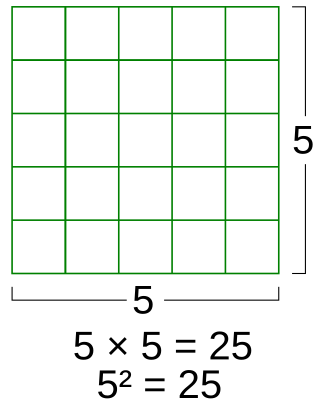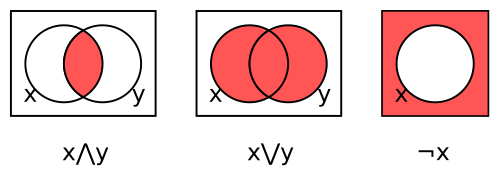
In mathematics, an associative algebraA over a commutative ring K is a ring A together with a ring homomorphism from K into the center of A. This is thus an algebraic structure with an addition, a multiplication, and a scalar multiplication. The addition and multiplication operations together give A the structure of a ring; the addition and scalar multiplication operations together give A the structure of a module or vector space over K. In this article we will also use the term K-algebra to mean an associative algebra over K. A standard first example of a K-algebra is a ring of square matrices over a commutative ring K, with the usual matrix multiplication.

In abstract algebra, a Boolean algebra or Boolean lattice is a complemented distributive lattice. This type of algebraic structure captures essential properties of both set operations and logic operations. A Boolean algebra can be seen as a generalization of a power set algebra or a field of sets, or its elements can be viewed as generalized truth values. It is also a special case of a De Morgan algebra and a Kleene algebra.

In mathematics, an integral domain is a nonzero commutative ring in which the product of any two nonzero elements is nonzero. Integral domains are generalizations of the ring of integers and provide a natural setting for studying divisibility. In an integral domain, every nonzero element a has the cancellation property, that is, if a ≠ 0, an equality ab = ac implies b = c.

In mathematics, a product of rings or direct product of rings is a ring that is formed by the Cartesian product of the underlying sets of several rings, equipped with componentwise operations. It is a direct product in the category of rings.

In mathematics, and more specifically in ring theory, an ideal of a ring is a special subset of its elements. Ideals generalize certain subsets of the integers, such as the even numbers or the multiples of 3. Addition and subtraction of even numbers preserves evenness, and multiplying an even number by any integer results in an even number; these closure and absorption properties are the defining properties of an ideal. An ideal can be used to construct a quotient ring in a way similar to how, in group theory, a normal subgroup can be used to construct a quotient group.

In mathematics, a semigroup is an algebraic structure consisting of a set together with an associative internal binary operation on it.
In mathematics, more specifically in ring theory, a maximal ideal is an ideal that is maximal amongst all proper ideals. In other words, I is a maximal ideal of a ring R if there are no other ideals contained between I and R.

In mathematics, rings are algebraic structures that generalize fields: multiplication need not be commutative and multiplicative inverses need not exist. Informally, a ring is a set equipped with two binary operations satisfying properties analogous to those of addition and multiplication of integers. Ring elements may be numbers such as integers or complex numbers, but they may also be non-numerical objects such as polynomials, square matrices, functions, and power series.
In mathematics, more specifically ring theory, the Jacobson radical of a ring R is the ideal consisting of those elements in R that annihilate all simple right R-modules. It happens that substituting "left" in place of "right" in the definition yields the same ideal, and so the notion is left-right symmetric. The Jacobson radical of a ring is frequently denoted by J(R) or rad(R); the former notation will be preferred in this article, because it avoids confusion with other radicals of a ring. The Jacobson radical is named after Nathan Jacobson, who was the first to study it for arbitrary rings in Jacobson 1945.

In ring theory, a branch of abstract algebra, a quotient ring, also known as factor ring, difference ring or residue class ring, is a construction quite similar to the quotient group in group theory and to the quotient space in linear algebra. It is a specific example of a quotient, as viewed from the general setting of universal algebra. Starting with a ring R and a two-sided ideal I in R, a new ring, the quotient ring R / I, is constructed, whose elements are the cosets of I in R subject to special + and ⋅ operations.
Ring theory is the branch of mathematics in which rings are studied: that is, structures supporting both an addition and a multiplication operation. This is a glossary of some terms of the subject.
In algebra, a unit or invertible element of a ring is an invertible element for the multiplication of the ring. That is, an element u of a ring R is a unit if there exists v in R such that
In ring theory, a branch of mathematics, an idempotent element or simply idempotent of a ring is an element a such that a2 = a. That is, the element is idempotent under the ring's multiplication. Inductively then, one can also conclude that a = a2 = a3 = a4 = ... = an for any positive integer n. For example, an idempotent element of a matrix ring is precisely an idempotent matrix.
In mathematics, particularly in algebra, the class of projective modules enlarges the class of free modules over a ring, by keeping some of the main properties of free modules. Various equivalent characterizations of these modules appear below.
In ring theory, a branch of mathematics, a ring is called a reduced ring if it has no non-zero nilpotent elements. Equivalently, a ring is reduced if it has no non-zero elements with square zero, that is, x2 = 0 implies x = 0. A commutative algebra over a commutative ring is called a reduced algebra if its underlying ring is reduced.

In mathematics, a square is the result of multiplying a number by itself. The verb "to square" is used to denote this operation. Squaring is the same as raising to the power 2, and is denoted by a superscript 2; for instance, the square of 3 may be written as 32, which is the number 9. In some cases when superscripts are not available, as for instance in programming languages or plain text files, the notations x^2 (caret) or x**2 may be used in place of x2. The adjective which corresponds to squaring is quadratic.
Boolean algebra is a mathematically rich branch of abstract algebra. Stanford Encyclopaedia of Philosophy defines Boolean algebra as 'the algebra of two-valued logic with only sentential connectives, or equivalently of algebras of sets under union and complementation.' Just as group theory deals with groups, and linear algebra with vector spaces, Boolean algebras are models of the equational theory of the two values 0 and 1. Common to Boolean algebras, groups, and vector spaces is the notion of an algebraic structure, a set closed under some operations satisfying certain equations.
GF(2) is the finite field with two elements. Notations Z2 and may be encountered although they can be confused with the notation of 2-adic integers.
In ring theory, a branch of mathematics, a ring R is a polynomial identity ring if there is, for some N > 0, an element P ≠ 0 of the free algebra, Z⟨X1, X2, ..., XN⟩, over the ring of integers in N variables X1, X2, ..., XN such that
This is a glossary of commutative algebra.




